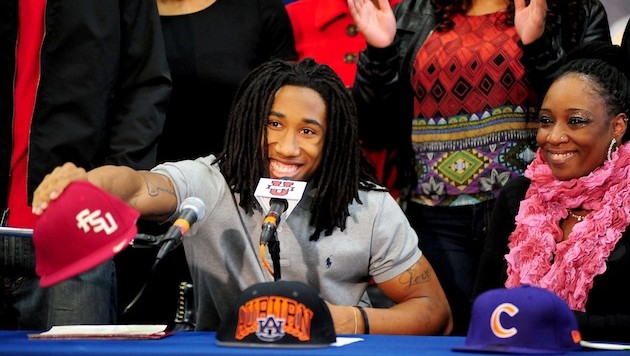Follow TSS on Twitter @TheStudentSect
National Signing Day is like going to vote. You have a bunch of people who think it matters and we should be paying full attention because it’s a harbinger of things to come … and a bunch of other people who think it’s meaningless.
So annually, I do this just to find out more about the validity of playing for championships and recruiting rankings. It’s fun in the sense that it’s not too much math to make me throw things and to sort of “grade” the people who do recruiting rankings.
The proof every year is pretty much found in the same thing, and that’s the fact that if you don’t have an “anchor” class (what I consider a top 5 class) among the last five (which are the ones that make up all of your roster unless you have some rare 6th year senior or whatever on it), you aren’t winning a championship. If you aren’t recruiting at a top 10 level somewhere in your roster in one individual class, you aren’t competing for a championship.
Rankings in the below table are provided by Scout.com. Class 1 denotes the most veteran class on the roster (your redshirt seniors) and class 5 denotes the freshmen.
Scout.com is used for a few reasons … one, it had a hand in publishing College Football News stuff when we (fellow TSS editors Matt Zemek and Terry Johnson) were there. Two, Scout doesn’t do its recruiting rankings by basically plugging Alabama in at number 1 every year and then going forward like some other sites that (Rival) them …
Obviously, the end result makes the people who run Scout.com (or Rivals, or 24/7) look really smart, since there isn’t massive deviation any year. For instance, Scout doesn’t have Iowa ranked number one while Rivals has them at 50 some year. However, it’s a bit flawed.
Since there are any number of 100,000 kids playing high school football annually, a lot of it goes based on who’s getting offers from whom. If Timmy 2-star suddenly shows up with Southern Cal, Alabama, and Texas offers, he becomes Timmy 4- or 5-star overnight. You gotta play to the audience, and Maine Football fans aren’t taking up the bulk of the subscriptions.
At any rate, a few observations are after the table — away with your merry day.
Note: Scout’s archives only go back to 2002, so 2004 Southern Cal and 2005 Texas are wildly incomplete, which is why I stopped there.
*
[table id=1 /]
– Every team which participated in the first College Football Playoff had a class average inside the top 10 over 5 years other than Oregon, who checked in at 16.
– Every playoff team also had one class that was ranked number 1 overall other than Oregon, and among those three, of their 15 combined classes, 10 finished ranked in the top 10 and 8 in the top 5.
– The highest recruiting class average over five classes was 11.8 by Alabama in 2009. Only two classes averaged above a top-10 class and won a national championship, and both of those teams had at least three top-10 classes.
-Even in terms of runners-up, only Oregon in 2010 featured an average class rating of below 15, and even the Ducks had one top-10 upper class to anchor that team, which is consistent with every program either winning or playing runner-up.
-Auburn in 2010 is the only team that won a BCS title without having at least one top-5 class. However, the Tigers had two classes ranked 6th.
-The lowest individual class rating for a BCS champion was 22 by Alabama. Basically, if you’re not recruiting every class in the top 25, you aren’t winning titles. Conversely, the lowest individual class for any of the runners-up was 52 from Oregon, which was an anomaly, 22 spots higher than the next highest-rated class.
*
What does all of this show? For the most part, it shows that if you’re putting together a top-10 anchor class and not having any outlier classes to skew your overall average — which means you’re recruiting well — you have a shot to compete for a championship. It also shows that recruiting sites probably don’t spend much time in Oregon, because the Ducks are the clear outlier in all of this, and as we know, most teams fill their roster with in-state talent no matter how nationally they recruit. Get out to Oregon, guys.

